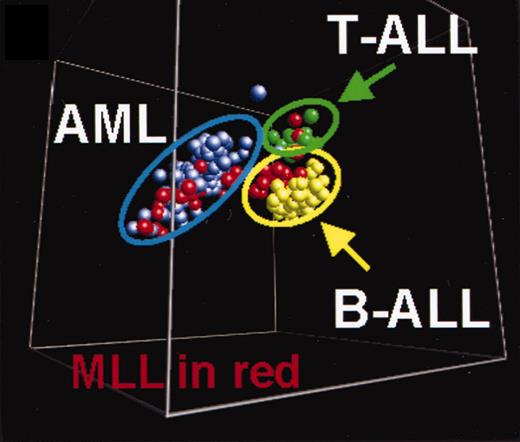Comment on Ross et al, page 3679
Gene expression profiling of pediatric acute myelogenous leukemias identifies signatures associated with recurrent chromosomal translocations including an MLL-associated signature found in both AML and ALL.
Gene expression profiling of cancer cells holds the promise of providing better clinical stratification schemes and the ability to predict response to therapy. Also, a detailed understanding of gene expression may help identify critical pathways that could be therapeutic targets. This is particularly true for hematopoietic malignancies, where a detailed understanding of the importance of recurrent chromosomal translocations can be used to aid interpretation of complex gene expression data sets.FIG1
Gene expression–based relationship between leukemias with MLL rearrangements and those without. See the complete figure in the article beginning on page 3679.
Gene expression–based relationship between leukemias with MLL rearrangements and those without. See the complete figure in the article beginning on page 3679.
Studies by Ross and colleagues in this issue of Blood use microarray analysis to define gene expression signatures associated with recurrent chromosomal translocations found in pediatric acute myeloid leukemia (AML). They identify distinct gene expression signatures associated with the most common translocations including those that encode promyelocytic leukemia–retinoic acid receptor α (PML-RARα), acute myeloid leukemia 1-821 (AML1-ETO), core-binding factor β–smooth muscle myosin heavy chain (CBFβ-MYH11), and mixed-lineage leukemia (MLL) fusion proteins. When the class discriminating genes are used to predict the presence of specific translocations, the gene expression–based classifier performs with 93% accuracy. Importantly, when AML samples obtained from adults are classified based on gene expression defined in pediatric samples, the classifier performs equally well. The inability to correctly classify a few samples appears to be a result of molecular heterogeneity in AMLs with either CBFβ-MYH11 or MLL translocations. While the explanation for such heterogeneity remains unknown, it raises interesting questions for further study.
A particularly intriguing aspect of the current study is the assessment of gene expression signatures associated with MLL rearrangements in leukemias characterized as T-lineage acute lymphoblastic leukemia (T-ALL), B-lineage ALL (B-ALL), or AML. When Ross et al performed unsupervised clustering of leukemia samples using principle component analysis, MLL-rearranged AMLs and T-ALLs were intermixed with the other AML and T-ALL samples, respectively. MLL-rearranged B-ALL samples, while “closest” to B-ALL, were clustered together and separate from other B-ALL samples (see figure). This provides support for the notion that MLL-rearranged B-ALLs are biologically distinct from other ALLs and provides new data showing that MLL-rearranged T-ALL and AML are biologically more similar to other leukemias of similar lineage. This is in concordance with clinical data where MLL rearrangements are associated with a particularly poor prognosis in B-ALL but not T-ALL or AML.1 Also, this analysis identified a “core” gene expression signature associated with MLL rearrangements despite the lineage classification. Presumably these genes represent important downstream mediators of MLL-induced leukemogenesis. While similar types of analysis have been performed previously,2-5 this is the largest study using well-annotated AML, T-ALL, and B-ALL samples and thus provides important new insight into the biology of these leukemias.
Gene expression studies such as this continue to provide important information about the biology of leukemia and suggest that gene expression–based classification schemes might improve upon those currently used. But, gene expression studies performed on human tumors are largely hypothesis-generating experiments and thus much work lies ahead in the testing of these hypotheses. A similarly demanding and equally important task will be demonstration of the ability to prospectively predict outcome using gene expression–based technologies. Despite these caveats, genomic analysis is providing an unprecedented view of the molecular events in leukemia.


This feature is available to Subscribers Only
Sign In or Create an Account Close Modal